The Economics and Statistics Division maintains archives of previous publications for accountability purposes, but makes no updates to keep these documents current with the latest data revisions from Statistics Canada. As a result, information in older documents may not be accurate. Please exercise caution when referring to older documents. For the latest information and historical data, please contact the individual listed to the right.
<--- Return to Archive
For additional information relating to this article, please contact:
October 10, 2018PROVINCIAL AND TERRITORIAL TOURISM SATELLITE ACCOUNT, 2014 Today Statistics Canada released the Provincial and Territorial Satellite Account, a measure of the size of provincial tourism as measured by expenditures, GDP and employment.
The Provincial and Territorial Tourism Satellite Account contains some important definitions. "Tourism industries" are industries which would cease to exist or would exist at significantly reduced levels of activity in the absence of tourism (e.g. air transportation, accommodation). Tourism commodities or products within industries are ones for which a significant part of their total demand comes from visitors (e.g. travel agency services and rail transportation services).
In Nova Scotia's results for 2014, there was $2.1 billion spent in the tourism industry. Tourism product spending was an estimated $1.7 billion or 81.3 per cent of all tourism expenditures, made up of Transportation (44.3%), Accommodation (18.8%), Food and Beverage Services (20.5%), and Other Tourism Products (16.4%). The remaining 18.7 per cent ($398.5 million) consisted of Groceries, Beer, Wine and Liquor from Stores, Urban Transit and Parking, and Miscellaneous Products.
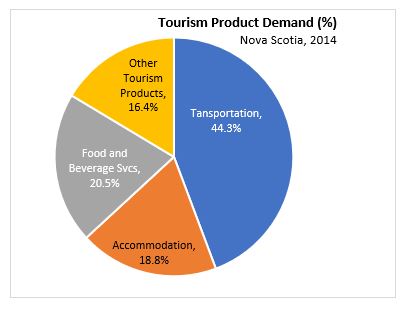
Tourism expenditures generated 2.3 per cent of Nova Scotia's Gross Domestic Product in 2014, valued at $829.2 million. Across Canada, tourism GDP accounted for an average of 1.9 per cent of GDP. Tourism share of GDP was highest in PEI at 3.0 per cent, and lowest in Newfoundland and Labrador and Saskatchewan, both at 1.3 per cent. Nova Scotia tourism activities accounted for 19,100 jobs in the economy.
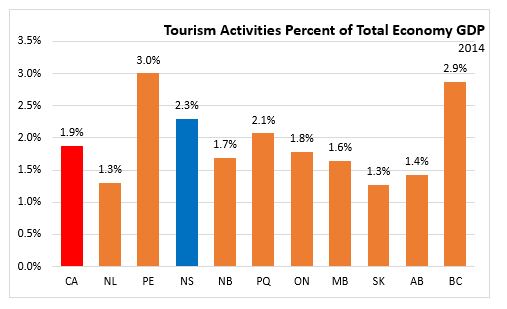
Domestic Demand (travel by residents from within a province) accounted for just under half of tourism product spending (49.0%), with the balance made up between interprovincial exports (visitors from another province in Canada) and international exports (visitors from another country) (51.0% combined).
Interprovincial spending was 26.9 per cent of total tourism spending, and international visitors accounted for 24.1 per cent of total spending. The largest expenditures for domestic and export tourism demand were on transportation. For exports, spending was then highest in accommodation (24.7% and 34.0% interprovincial and international, respectively), followed by Food & Beverage services (23.7% and 17.9%), and other tourism products (11.3% and 11.6%).
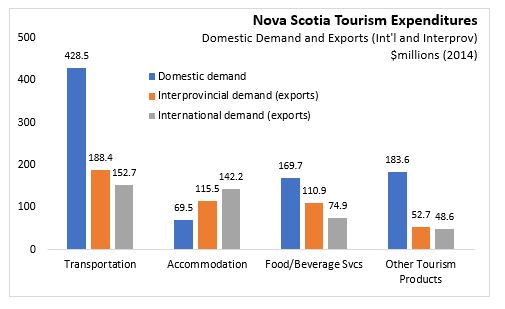
Employment in the tourism industry accounted for 3.2 per cent of all jobs in Nova Scotia in 2014, higher than the national average of 2.8 per cent. Tourism jobs were highest (in proportional terms) in PEI (5.4%) and BC (4.3%), and lowest in Manitoba and Saskatchewan (both 2.2%).
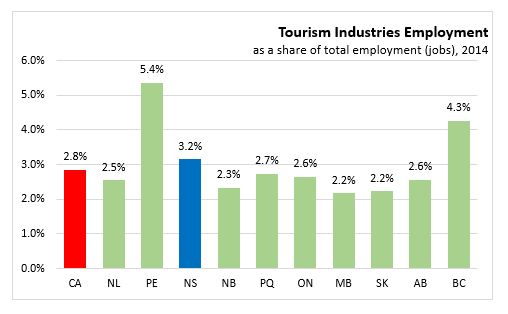
Tourism jobs in Nova Scotia were concentrated in the food and beverage services sector, followed by accommodation, and recreation and entertainment. Contribution to GDP was highest in accommodation ($191.8 million), followed by food and beverage service sector ($151.9 million), and transportation ($140.9 million).
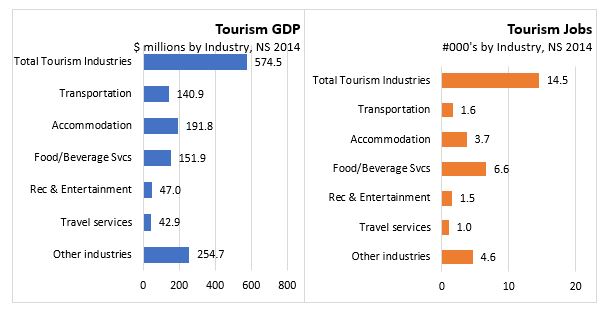
Tourism's contribution to employment was higher than its contribution to GDP in all provinces and territories.
Source: Statistics Canada. Provincial and territorial tourism satellite account, 2014.
Statistics Canada Data Portal: Table 24-10-0004-01 and 24-10-0042-01
<--- Return to Archive